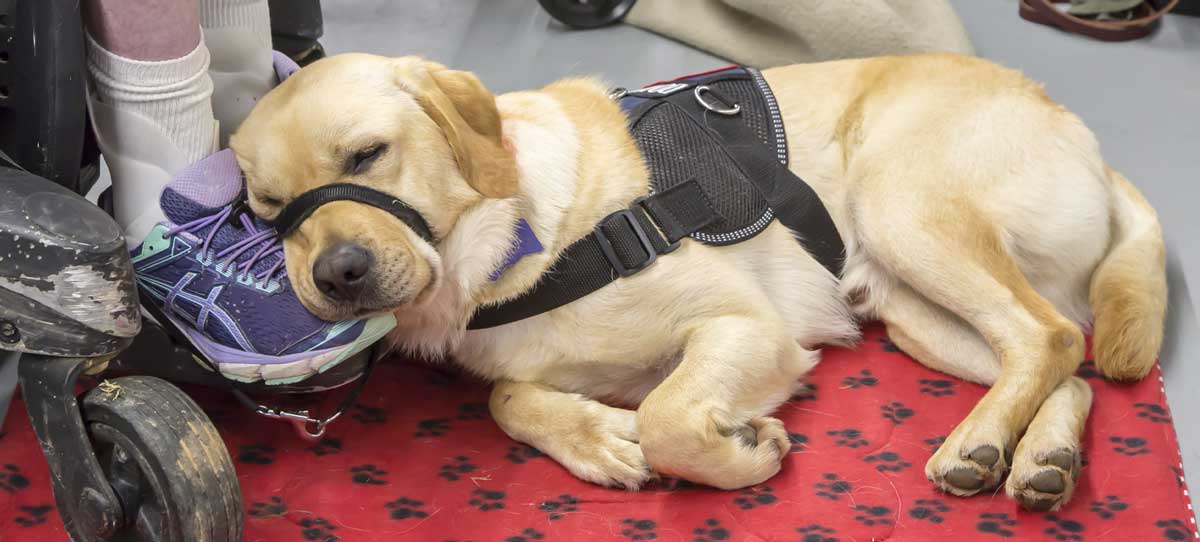
The first Sunday in August is the start of International Assistance Dog Week, a celebration of the “devoted, hardworking assistance dogs helping individuals mitigate their disability-related limitations.” Visit the IADW website for more on International Assistance Dog Week and the organizations supporting this event.
Here are some things to know about service dogs:
1. What is a service dog, and how is it different from an emotional support or therapy dog?
The ADA defines a service dog as one that has been individually trained to do work or perform tasks for an individual with a disability. The dog must be trained to take a specific action that is directly related to the disability. For example, a dog trained to alert their handler with diabetes that their blood sugar is too high or too low; the skill of the dog is directly related to the disability.
Service dogs are required under the ADA to be allowed access to places open to the general public. Emotional support, therapy, and companion dogs have looser definitions and since they are not required to perform a specific task for a disabled person, they do not have federal protections. This is not to say that they do not provide comfort and value to their owners, but different rules apply. State and local ordinances may offer protections to emotional support animals.
2. Can a cat, lizard, bird or other domesticated animal be recognized as a service animal?
No, the ADA only acknowledges dogs in their ability to function as a service animal, however, some trained miniature horses are recognized as a service animal. For the sake of this article, we will only refer to service dogs.
3. Who uses service dogs?
People might be most familiar with guide dogs, which are dogs trained to assist a blind or vision-impaired handler. However, service dogs are also trained to assist people in wheelchairs, people with epilepsy or seizure disorders, people with psychiatric conditions including PTSD, people who are hard of hearing and people with autism.
4. Can any dog be a service dog?
Under ADA guidelines, yes. There are no breed-specific requirements to meet ADA compliance.
Most organizations that train service dogs use specific breeds that are known for their trainability, temperament, and skills specific to the type of function they will be trained for and may or may not train an existing family pet.
5. Does the dog need to be professionally trained to qualify as a service animal?
No. The ADA allows people to train their service dog themselves. However, you may wish to seek professional assistance depending on your needs.
6. Do service dogs need to show certification or a license?
The ADA does not require service dogs to wear anything identifying them as a service dog, and the handler is not required to show documentation to anyone asking if their animal is a service dog. A handler may choose to give their animal a vest or tags indicating that they are a service dog, but that is the decision of the handler.
Staff of a restaurant or public building asking to verify if the animal is a service dog can only ask:
- Is the dog a service animal required because of a disability?
- What work or task has the dog been trained to perform?
- What organizations train/pair people with service dogs?
There are many different organizations that train service dogs, and many are region-specific. Assistance Dogs International is a good place to start in your search for an organization in your area that trains service dogs. You can also look for a service dog in your area by searching for “service dog + disability + region” (example “service dog + veteran PTSD + Texas”).
7. What is the process of being paired with a service dog?
Each organization will have its own application and training period, depending on the task(s) the dog is being trained to perform. The waitlist to be paired with a professionally trained service dog can be months or even years. The organizations that train these dogs want to make sure that the best match possible is made between a service dog and a handler.
After the animal is trained at their facility, there is typically an in-home training session that may last a few weeks. At this time, the skills the dog has learned are transferred to the handler’s home, and the dog and handler train with each other under the guidance of the trainers.
8. How much do professionally-trained service dogs cost?
Organizations that train service animals can spend upwards of $40,000 per dog, between breeding, raising the dog and training. Depending on the organization, most of those costs are covered by private donations, but there may be costs that the handler will need to cover, such as material costs and the room and board costs for trainers during the in-home training session. As with any animal in your home, there are also standard costs of raising a dog, including Veterinary care and food that is the obligation of the handler.
For more on fundraising, see here.
For more information on the ADA protections related to service dogs, please see here:
https://adata.org/guide/service-animals-and-emotional-support-animals
National Ramp joins in the celebration of the wonderful tasks performed by service dogs on behalf of their disabled handlers across the world. When you encounter a service dog in public, remember that they are actively working, try not to interfere with the dog or their handler, and never pet a service dog without permission. If you do receive permission to pet a service animal, be sure to tell them that they are a good dog!

Don’t Risk Injury To You Or A Loved One
Why wait? Give us a call at 877-596-7293 or contact us online to get started!